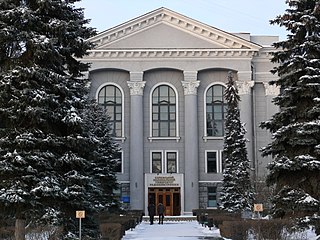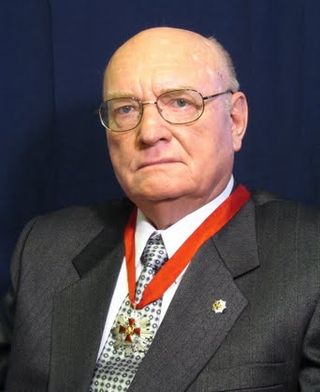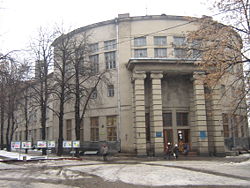
Lviv Polytechnic National University is a public university in Lviv, Ukraine. It was founded in 1816.

The National (Metsovian) Technical University of Athens, sometimes known as Athens Polytechnic, is among the oldest higher education institutions of Greece and the most prestigious among engineering schools. It is named Metsovio(n) in honor of its benefactors Nikolaos Stournaris, Eleni Tositsa, Michail Tositsas and Georgios Averoff, whose origin is from the town of Metsovo in Epirus.

Kyiv Polytechnic Institute is a public technological university in Kyiv, Ukraine.

The National Polytechnic University of Armenia is a technical university located in Yerevan, Armenia. Established as the Karl Marx Institute of Polytechnic in 1933, it provides educational and research programs in various fields of technology and science related to engineering. The university includes a central campus in Yerevan and branch campuses located in Gyumri, Vanadzor and Kapan. Currently there are more than 8,000 students and more than 750 faculty members.

National Research Tomsk Polytechnic University (TPU) is a technical university in Russia. TPU was a member of 12 international associations, including the Conference of European Schools for Advanced Engineering Education and Research (CESAER) until it was suspended in March 2022, and the European University Association (EUA) until it was suspended in March 2022. TPU was included in Project 5-100, a 2013 state program aimed at bringing at least five Russian universities from among the project participants into the 100 best universities in the world.

Azerbaijan Technical University is a public university, specialized in engineering, located in Baku, Azerbaijan. The University has 9 schools and 54 departments, 884 faculty members and approximately 6500 students.

Peter the Great St. Petersburg Polytechnic University, abbreviated as SPbPU, is a public technical university located in Saint Petersburg, Russia. The university houses one of the country's most advanced research labs in hydro–aerodynamics. The university's alumni include Nobel Prize winners, such as Pyotr Kapitsa and Zhores Alferov, physicists and atomic weapon designers such as Yulii Khariton, Nikolay Dukhov, Abram Ioffe, Aleksandr Leipunskii, and Yakov Zeldovich, aircraft designers and aerospace engineers, such as Yulii Khariton, Oleg Antonov, Nikolai Polikarpov, and Georgy Beriev, and chess grandmasters, such as David Bronstein. The university offers academic programs at the Bachelor, Master's, and Doctorate degree levels. SPbSPU consists of structural units called Institutes divided into three categories: Engineering Institutes, Physical Institutes, and Economics and Humanities Institutes. In 2022, the university was ranked #301 in the world in the Times Higher Education (THE) World University Rankings, #393 in QS World University Rankings, #679 in Best Global Universities Rankings by U.S. News & World Report, and #1,005 by Center for World University Rankings.

Vasyl' Stus Donetsk National University (Vasyl Stus DonNU) (Ukrainian: Донецький національний університет імені Василя Стуса, romanized: Donetskyi natsionalnyi universytet imeni Vasylia Stusa; Russian: Донецкий национальный университет имени Василия Стуса, romanized: Donetskiy natsionalnyy universitet imeni Vasiliya Stusa) is one of the leading higher educational institutions of Ukraine. The university's history starts in 1937 from the moment of the creation of a pedagogical institute in Donetsk (then Stalino). In 1965, the institute was transformed into Donetsk State University. It was accorded the National status in 2000.

Donetsk National Technical University is the biggest and oldest higher education establishment in Donbas, founded in 1921. In its early years, it was attended by Nikita Khrushchev.

The Admiral Makarov National University of Shipbuilding in Mykolaiv is a higher education institution which trains specialists for the shipbuilding and allied industries of Ukraine. The university is named after Russian admiral Stepan Makarov, who was born in the city.

Kharkiv National Medical University, formerly known as Kharkiv Medical Institute and previously Kharkiv State Medical University, is a medical university in Kharkiv, Ukraine. In March 2022 many buildings were heavily damaged due to the Russian invasion into Ukraine.

The Dnipro University of Technology is a public polytechnic in Dnipro, Ukraine.

National Aerospace University – "Kharkiv Aviation Institute", NAU "KhAI" is a university in Kharkiv, Ukraine which specializes in aviation and space engineering. The KhAI was founded in 1930.

Sumy State University (SumDU) is a higher educational institution in Sumy, Ukraine. It enrolls about 12,000 students pursuing pre-undergraduate, undergraduate, specialist, and master degrees in 55 majors and 23 fields. About 1,900 foreign students represent almost 50 countries worldwide.

Kharkiv National University of Radio Electronics (NURE) (Ukrainian: Харківський національний університет радіоелектроніки) is a technology university based in Kharkiv, Ukraine. Founded in 1930, it is among the oldest technologically focused universities in Ukraine, with a student body of around 7,000.

Lutsk National Technical University is a Ukrainian university in Lutsk at the IV accreditation level.

National University "Yuri Kondratyuk Poltava Polytechnic" is a Ukrainian university in Poltava. It is located on Pershotravneva Avenue. Previously known as Poltava National Technical Yuri Kondratyuk University, PoltNTU.

Sevastopol National Technical University, formerly known as the Sevastopol Engineering Institute, is a university in Sevastopol, Crimea.

Kharkiv National Automobile and Highway University is a Ukrainian university in Kharkiv.

Alexey Petrovich Stakhov is a Ukrainian mathematician, inventor and engineer, who has made contributions to the theory of Fibonacci numbers and the "Golden Section" and their applications in computer science and measurement theory and technology. Doctor of computer science (1972), professor (1974). Author of over 500 publications, 14 books and 65 international patents.
























